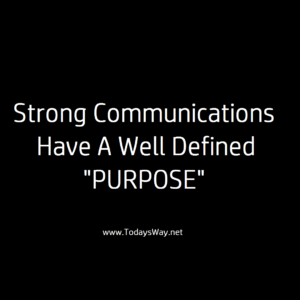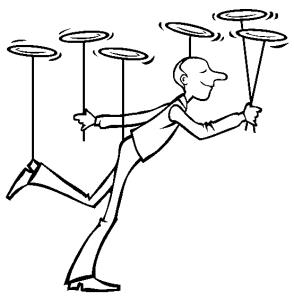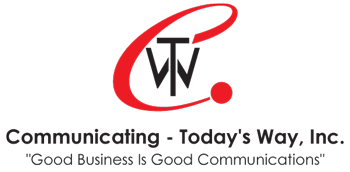“YES” To Having Captive Audiences!
 Isn’t it great when you have a captive audience? When your listeners hang on to every word you say as you speak to a group or even just a single individual! There are some people who experience this magic every time they speak. You can probably think of a few right now who always have people stop and listen to every word they say.
Isn’t it great when you have a captive audience? When your listeners hang on to every word you say as you speak to a group or even just a single individual! There are some people who experience this magic every time they speak. You can probably think of a few right now who always have people stop and listen to every word they say.
The good news is that it doesn’t always require “magic” to experience this yourself. There are multiple ways to go about experiencing a captive audience. As you begin to implement one or several of the available “ways” you’ll start seeing an increase in your connectivity. Slowly but surely … you’ll experience a captive audience all the time!
One specific way to begin obtaining a “captive audience” is to use the structure of a story in “all” your communications. Stories have a successful track record from everyone’s childhood to adulthood in making us stop and listen. When someone says, “let me tell you a story,” you can almost feel a shift in your “being” as you go into a more relaxed mode. You sit back and listen, and “connect!”
So what is it about stories? What do stories do? First they get your attention, directing you away from where you are. Then something happens as the story unfolds. Lastly closure is provided. Each segment flows to the next. AND within each segment, each sentence connects and flows to the next as do each of the words used in each sentence … bringing you into the “tide” of the story, and keeping you there (via the structure) until the ending!
When a story ends, you walk away with a complete A-Z communication that via its completeness has been listened to and heard. The pieces “connect & flow” AND MOST IMPORTANTLY the “communication” is remembered because of the “closure” that is used. How often, when asked to describe a book or a movie, do you maybe get fuzzy on the pieces of the “happening” but you can always share how it ends …right?
The story structure works wonderfully, as you would expect, when telling an actual story and/or when putting your marketing message into a story scenario. BUT ALSO, the story structure works wonderfully in ALL types of communications.
Lets break down the structure of a story as you might implement it in ALL types of communications:
- OPENING!
Openings are used to catch attention, set the stage, get your listeners & readers in sync, get your listeners & readers positioned & ready to hear the next part of your communication.Openings can vary in style:
Simple: ATTENTION! HEADS UP! PICTURE THIS!
Targeting: Are You A 45+ Year Old Runner?
Introduction: A love of soccer is sweeping the USA!!!
Actual Story Telling: A Financial Planning client came into my office today. His pain was great and his stress level high!
. - SOMETHING HAPPENS!
From the stage that is set in the opening, a message is shared. The message might be:
A simple announcement.
Sharing of information.
Making a point.
Sharing emotions.
A happening.
An actual story
. - CLOSURE!
Closure provides completeness, an ending … something that is required by our human DNA. We look for it in everything we do, from eating dessert, to knowing the answer to a mystery, to getting over a loved one’s death, to finishing a book, to graduating from schools ,… we thrive on having “closure & completeness!”
.
When you provide closure, even in the simplest of communication it is like dotting the “i” and crossing the “t.” If you don’t provide it, you can get by without it. People usually know what you mean or fill in their own closure, BUT it is so much stronger and you make a much more cleaner “complete” connection when you do dot the “i” & cross the “t.”Adding closure to all your business communications, short & long will add that extra glue for connecting to and captivating your audiences.Closure can be of several types with each type, in one way or another, summarizing & delivering the WHY of your communications. Some of the types are:
Simple Statement: See You There!
Call To Action: Buy Now!
Emotion: Cheers & Joy!
Direct WHY: To Your HEALTH!
A Result: They lived happily ever after.
Use the structure of a story in ALL your communications, short & long. Here is a short communication shown with partial use of a story structure and then with complete use of the story structure:
- With partial story structure – using Opening & Message only.
Greetings! Have a wonderful day.
This can work, i.e you can get by with this. Does it captivate?
. - With complete story structure – adding a “closure” with the WHY.
Greetings! Have a wonderful day. You deserve it.
Quietly say both of these greeting to yourself as though you are receiving them from someone else and see if you experience an extra “bond” when (the why) “you deserve it” is added at the end. Specifically including the “why” … not assuming it .. provides immediate clarity for “connecting!” AND I ask you, which greeting “captivates” you more?
There are so many ways to apply the story structure to your business communications for having captive audiences. Turning your marketing messages into stories is an obvious and very KEY way. Structuring “ALL” your communications around the story structure is a bigger way that will enable you to tremendously increase your connectivity with all audiences both online AND offline.
If you are catching on to what I am sharing, start creating your communications with the story structure and let me know the differences you experience. This post will be here for a long while. Just come back and comment.
If you are not quite comfortable with how you would start using the story structure, I invite you to schedule a private workshop with me for assistance. We can customize a workshop specific to your business and your learning needs. Your email or phone call is welcomed. 310-306-1453 or margieh@todaysway.net
In today’s business world, making less than “complete” connections with your audiences is almost equal to making no connections. There is just too much information out there. You can’t afford to be lost in the crowd. You must know how to “captivate” will all your communications.
Join me in saying, “YES” To Having Captive Audiences!
Enjoy ….
margie
www.todaysway.net
***
About me: I’m your “go-to” for knowing how to create effective online communications that will attract, connect, engage and convert online prospects into buyers. Also the creator of my signature “Content Mktg Power Workshop.” Added value: 20+ years in corporate voice & data sales & marketing plus 15 years as an entrepreneur. I “get” you!
*****
Stay in touch via my weekly “Keep Your Business Growing” emails, click here. Visit my website and ask for a complimentary consultation .http://www.todaysway.net/complimentary-consultation/
Are You Sending STRONG Communications?

I’ve been talking about being ready for the 2nd half of 2016 and if you are ready. One ot the best ways you can be ready and better than ever is to concentrate on your communications.
The more “effective” you make the communications you send, the more connections you will make and keep! So this week I am touching upon one piece of creating quality communications – I am sharing with you ways to know if you are sending STRONG communications and why you want to!
Communications are the core of all that we do in business and life. Everything is a communication! Today our business communications are “live” and ever flowing. Marketing is all about providing fresh daily communications in social media and blog posts for connecting to buyers. The days of creating one message for one ad that runs for a month are fewer and fewer.
Bottom Line: You have to know how to create effective messaging both online and offline!
The question being asked above iin today’s title is, “are you sending “strong” communications?” If you are asking, “what does “strong” mean? Loud? In your face? Bold?” The answer is NO … none of these define “strong” as applied in this question.
A short list of definitions for “strong,” as used with communications, includes lasting, clear, clean, exact, deep, quality, solid, meaningful and “right on!”
- .If you look at the lights on your computer modem or router you can immediately tell if you have a strong connection/communication.
- When you are on the phone you can tell when you have a strong or weak connection/communication going on.
- When you plug in a new lamp and it flickers, you know you have a weak connection/communication going on somewhere within the process of the lamp turning the bulb on .
It’s the same with human communications. You can tell when you have a strong or weak communication. Sometimes it takes being extra aware, as there is a buffer used by humans that lets a lot slide by. This mailing is beign sent to you with the hopes of encouraging all to be extra aware.
Here’s a 7 item checklist you can use as a starting guideline for knowing if you are sending strong communications:
- Strong communications have a defined purpose.
Before they are created, a clearly defined “WHY” is identified for the communication.
. - Strong communications start with the end in mind.
You can not start out to make a connection unless you first know what you are connecting to. You must begin with knowing where you are going.
. - Strong communications have no gaps.
There are no “breaks” in strong communications. No starting and stopping.Only continuous “connecting” communications.
. - Strong communications include no shortcuts.
Communications are authentic, real, honest and complete! The Golden Rule for success with all online communications is to remove the need for the reader to have to think. No guessing. No grey. No shortcuts!
. - Strong communications have no weak links.
Communications are made up of words connecting to words and sentences connecting to sentences, and paragraphs connecting to paragraphs. If there is any weakness in any of the pieces as they connect , each one to the next one, it robs the strength of the entire communication.
. - Strong communications have value.They communicate a message that is truly useful, meaningful, elevating, enhancing, and lasting, a message that remains in the minds of those receiving the communications.
. - Strong communication are felt.
Reactions to a strong communication might be, “Right On!” or “You Got It!” or “That Hit Home!” or “YES!” etc.
Take this list and use it as a reference as you create your communications. If you are not sure, feel like your communications are missing the “strength” you want them to have contact me! You can have a customized training created for you. It’s a must that you know how to create quality communications going forward and I am here to help you.
Enjoy!
Is Daily Online Posting Giving You Writer’s Block?

Are you one of many who can never think of what to say in your online business postings? Especially when you are dedicated to maintaining daily visibility? It can be very frustrating at best.
- Do you think you are “over-thinking” it?
- Maybe your ideas all sound the same because you can’t get past the broad definition of what you do?
- Maybe you are used to writing ads that speak “to or at” many vs. the engagement style of social media?
There are many reasons for “writer’s block” when it comes to writing posts. BUT it’s a block you must break through if you want to be successful on social media.
.
Here are five ways to come up with great ideas that are specific to your business. Hopefully they will get you going immediately! More…
How Do You Keep All Your Online Plates Spinning?
 Keeping them spinning is one thing, but you have to first “get” them to spin!
Keeping them spinning is one thing, but you have to first “get” them to spin!
So how do you make that happen? If we look at the image above and use it as a guideline, you have to assume that you can’t begin with them “all” immediately spinning.
It makes sense that the first “concrete” step is to know your physical limits. How many plates can you physically spin? How many places are there on your body enabling you to have a plate spin?
Next would be to organize the identified “places” and plan which plate would be number one and what sequence would enable you to continually add plates without losing the “spin” on the first plates. Some sense of connectivity would kick in that will hopefully propel continuous spinning while not losing the existing spinning.
Finally you have to know this does not come easily. Consistent practice is what will “get” and “keep” all your plates spinning!
It works the same with keeping all your online resources in motion. You can’t just jump in and have multiple online resources “spinning” for you.
- First you must know what your limits are. Just how many online resources can you and could you keep in motion if it made sense to do so? What is the maximum needed and what is the minimum?
- Next if you know your purpose for using online resources you can easily organize your implementation around what makes sense purpose wise. Also if one online resource feeds the next resource in a “connecting” way, you can gradually add your selection of online resources as it makes sense. One will build upon the next, making it useful and desirable to use and keep all of them in motion!
- And yes, all this is for naught if you don’t consistently put it into action daily. The good news is it’s like anything new. If you make yourself create the habit you will see the benefits and want to spend even more time on it!
Online marketing is here to stay. If you approach it with care and “purpose” you will be on top of all that comes your way. You’ll know which plates you need to spin, which ones you want to spin and which ones you “can” and “can’t” spin!
Mapping out a plan of action for your online resources helps tremendously. It is something we do here at Today’s Way. Please do not hesitate to inquire how we may be of service to you!
Enjoy!
margie
Where & How To Find “Specific” Types Of Contacts Online!
.
Twitter and LinkedIn, are two online resources where you can search for specific types of contacts; CEO’s, VP’s, Business Owners, Runners, Moms, and anything else you may want to connect with!
Twitter offers a more casual environment that also provides “immediate” engagement. You can search for CEO’s, VP’s, Business Owners, Moms, Runners, Seniors, etc and start immediately engaging with their tweets if you like!
How it works is you log into your Twitter account and simply put the “type” of contact you are looking for in the search window. A list of “people” will appear in the dropdown. The very last option on the dropdown is “search all people for [type]” A full page of people, three across, will be presented! This is when you can also filter your results by those closest to you geographically. As you start exploring each one, you’ll know which ones are active and available to engage with.
More…
Connect With Me On Snapchat!
.
.

7 Ideas For “What To Talk About” In Online Business Postings!
7 Ideas For “What To Talk About” In Online Business Postings!
Are you one of many out there who can never think of what to talk about in your online business postings? It is probably the one factor that makes people “think” social media takes too much time … they never know what to say!
The fact is there is so very much for you to share as business people! There are endless thoughts, types of information, news, insights, etc available to you. There is absolutely no reason to ever suffer from writer’s block.
Here are 7 ideas for “what to talk about” in your online postings. Take them to heart and they will propel you into an endless generation of awesome business postings. Postings that will attract, connect and convert your readers into clients. Postings that help you grow your business! More…
5 Ways To Post About Your Business Without Talking About Your Business
How do you talk about your business in daily online postings without appearing to be selling, advertising, simply trying to push people into doing business with you?
How can I post about my business, but mix it up. Make my postings be related to my business but be more interesting and not all sound the same?
These are questions I get asked quite frequently. And there are so many answers. There are literally unlimited ways to post about your business comfortably AND in a variety of “original” interesting ways.
Here are just 5 ways for you to post about your business without talking about your business: More…
How Did You Name Your Business? Some Food For Thought.
How did you name your business? Did you choose a name to make a statement, have an energy of its own? Did you intend it to be a reflection, a symbol or perhaps send a message?
There can be a lot to think about when choosing a name for one’s business and sometimes the names just come easily! You usually begin with some kind of “starting” principle or point of reference, just as you do when naming a baby or even a pet! But then what happens?
Let’s look at a few major companies and how they chose their names: More…


FREE GIFT!
310-306-1453